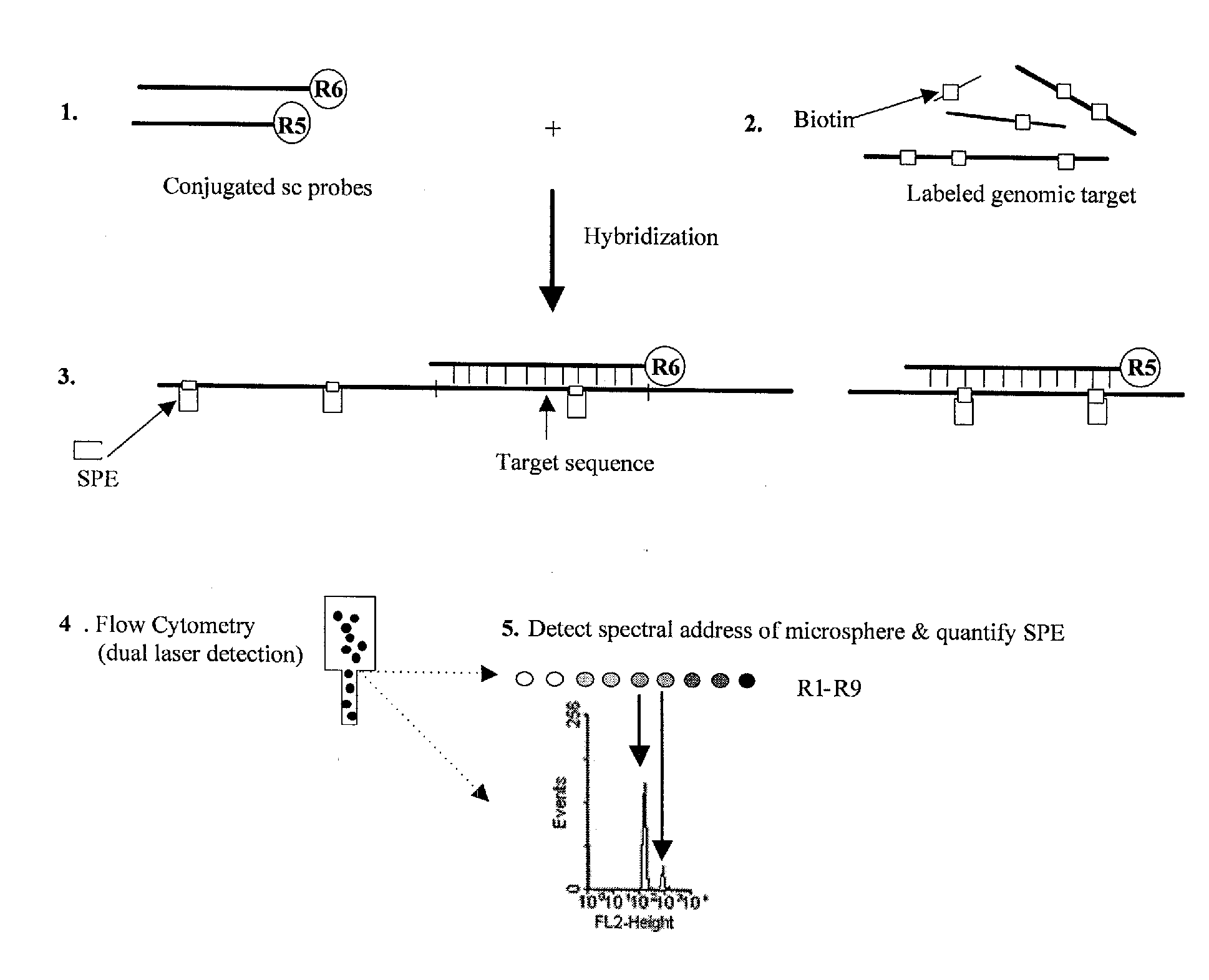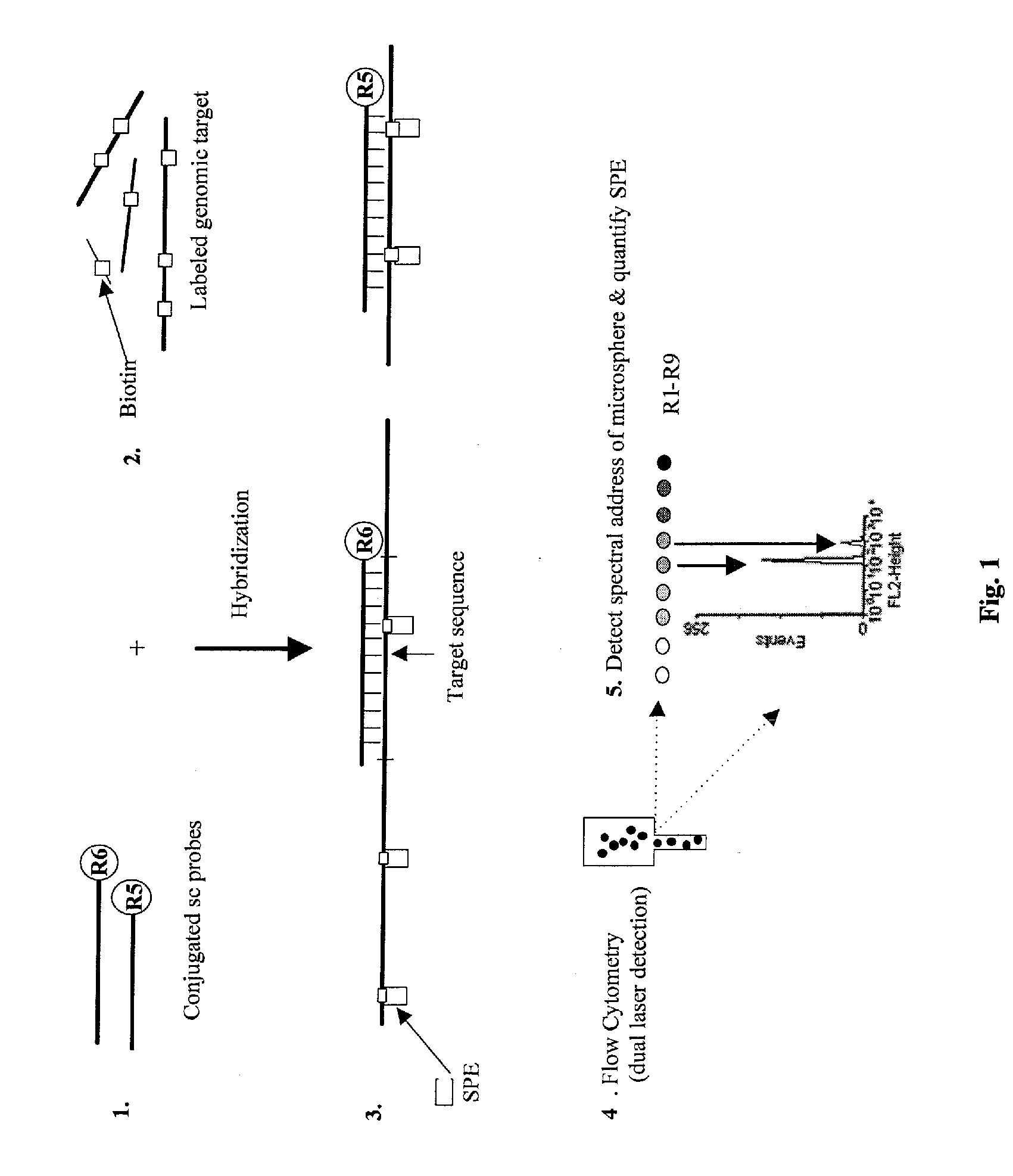Quantification of microsphere suspension hybridization and uses thereof
a technology of microsphere suspension and hybridization, which is applied in the field of detection of chromosomal abnormalities, and can solve the problems of reducing the analysis time and overall cost per sample tested, and reducing the amount of sample required per assay
- Summary
- Abstract
- Description
- Claims
- Application Information
AI Technical Summary
Benefits of technology
Problems solved by technology
Method used
Image
Examples
example 1
References for Example 1
[0136]The following reference materials are hereby incorporated by reference.[0137]Armour J A L, Sismani C, Patsalis P C, Cross G. 2000. Measurement of locus copy number by hybridisation with amplifiable probes. Nucleic Acids Res. 28 (2):605-609.[0138]Bagwell C B, Baker D, Whetstone S, Munson M, Hitchcox S, Ault K A, Lovett E J. 1989. A simple and rapid method for determining the linearity of a flow cytometer amplification system. Cytometry 10 (6):689-94.[0139]Brown R D, Zarbo R J, Linden M D, Torres F X, Nakleh R E, Schultz D, Mackowiak P G. 1994. Two-color multiparametric method for flow cytometric DNA analysis. Standardization of spectral compensation. American Journal of Clinical Pathology 101 (5):630-637.[0140]Coder D M, Redelman D, Vogt R F. 1994. Computing the central location of immunofluorescence distributions: logarithmic data transformations are not always appropriate. Cytometry 18 (2):75-8.[0141]Dunbar S, Godbout R, Newkirk H, Hetzel J. 2003. Micr...
example 2
References for Example 2
[0161]The following reference materials are hereby incorporated by reference.[0162]Amos-Landgraf J M, Ji Y, Gottlieb W, Depinet T, Wandstrat A E, Cassidy S B, Driscoll D J, Rogan P K, Schwartz S, Nicholls R D (1999) Chromosome breakage in the Prader-Willi and Angelman syndromes involves recombination between large, transcribed repeats at proximal and distal breakpoints. Am J Hum Genet 65:370-386.[0163]Bejjani B A, Shaffer L G (2004) A cytogeneticist's perspective on genomic microarrays. Hum Reprod Update 10:221-226[0164]Bittel D C, Butler M G (2005) Prader-Willi syndrome: clinical genetics, cytogenetics and molecular biology. Expert Reviews in Molecular Medicine 7:1-20.[0165]Bittel D C, Kibiryeva N, Talebizadeh Z, Butler M G (2003) Microarray analysis of gene / transcript expression in Prader-Willi syndrome: deletion versus UPD. J Med Genet 40:568-574.[0166]Bittel D C, Kibiryeva N, Talebizadeh Z, Driscoll D J, Butler M G (2005) Microarray analysis of gene / trans...
PUM
| Property | Measurement | Unit |
|---|---|---|
| diameter | aaaaa | aaaaa |
| diameter | aaaaa | aaaaa |
| temperature | aaaaa | aaaaa |
Abstract
Description
Claims
Application Information
 Login to View More
Login to View More - R&D
- Intellectual Property
- Life Sciences
- Materials
- Tech Scout
- Unparalleled Data Quality
- Higher Quality Content
- 60% Fewer Hallucinations
Browse by: Latest US Patents, China's latest patents, Technical Efficacy Thesaurus, Application Domain, Technology Topic, Popular Technical Reports.
© 2025 PatSnap. All rights reserved.Legal|Privacy policy|Modern Slavery Act Transparency Statement|Sitemap|About US| Contact US: help@patsnap.com



